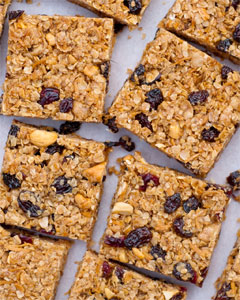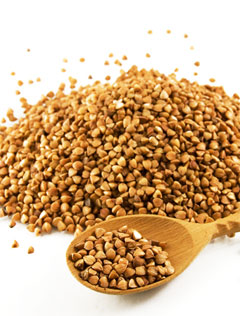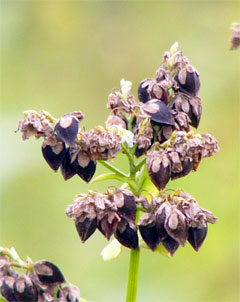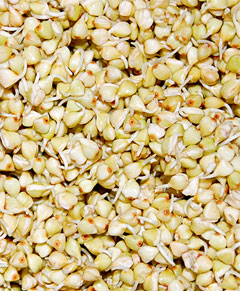|
|
Buckwheat: Gluten free Power Food

Buckwheat is a plant cultivated for its grain-like seeds, and also used as a
cover crop. Despite the name, buckwheat is not related to wheat, as it is not a
grass; instead, buckwheat is related to sorrel, knotweed, and rhubarb. The
cultivation of buckwheat grain declined sharply in the 20th century with the
adoption of nitrogen fertilizer that increased the productivity of other
staples. A related species, Fagopyrum tataricum (Tartary buckwheat) is also
cultivated as a grain in the Himalayas.
The name 'buckwheat' or 'beech wheat' comes from its triangular seeds, which
resemble the much larger seeds of the beech nut from the beech tree, and the
fact that it is used like wheat. The word may be a translation of Middle Dutch
boecweite : boec (modern Dutch beuk), beech (see PIE bhago-) + weite (mod. Dut.
weit), wheat; or may be a native formation on the same model as the Dutch word.
Buckwheat is raised for grain where a short season is available, either because
it is used as a second crop in the season, or because the climate is limiting.
Buckwheat can be a reliable cover crop in summer to fit a small slot of warm
season for establishment. It establishes quickly, which suppresses summer weeds.
The fruit is an achene, similar to sunflower seed, with a single seed inside a
hard outer hull. The starchy endosperm is white and makes up most or all of
buckwheat flour. The seed coat is green or tan, which darkens buckwheat flour.
The hull is dark brown or black, and some may be included in buckwheat flour as
dark specks. The dark flour is known as bl� noir (black wheat) in French, along
with the name sarrasin (saracen).
Buckwheat noodles have been eaten by people from Tibet and northern China for a
long time, as wheat can not be grown in the mountain regions. A special press
made of wood log was built to press the dough into hot boiling water when making
buckwheat noodles. Old presses found in Tibet and Shansi share the same basic
design features. The Japanese and Koreans might have learned the making of
buckwheat noodles from them.
Buckwheat contains a glucoside called rutin, a phytochemical that
strengthens capillary walls. One clinical study showed mixed results in the
treatment of chronic venous insufficiency. Dried buckwheat leaves were
manufactured in Europe under the brand name "Fagorutin" for use as a tisane. It
also contains galloylated propelargonidins and procyanidins.
Buckwheat contains D-chiro-inositol, a component of the secondary messenger
pathway for insulin signal transduction found to be deficient in Type II
diabetes and polycystic ovary syndrome. It is being studied for use in treating
Type II diabetes. Research on D-chiro-inositol and PCOS has shown promising
results. High protein buckwheat flour is being studied for possible use as a
functional ingredient in foods to reduce plasma cholesterol, body fat, and
cholesterol gallstones.
Buckwheat contains more protein than grains and is not deficient in the amino
acid lysine as most grains are, so the protein is more nutritionally complete.
That makes it a particularly good choice for vegetarians. It's an excellent
source of magnesium, a boon to your blood pressure. A phytochemical in buckwheat
may be beneficial in the management of diabetes; studies show it may have the
ability to lower blood glucose levels. It's also a good source of fiber.
Health Benefits of Buckwheat
 1.
Best source of high-quality, easily digestible proteins. 1.
Best source of high-quality, easily digestible proteins.
This makes it an excellent meat substitute. High protein buckwheat flour is
being studied for possible use in foods to reduce plasma cholesterol, body fat,
and cholesterol gallstones.
2. Fat alternative.
Buckwheat starch can also act as a fat alternative in processed foods.
3. The high level of rutin is extracted from the leaves for medicine to treat
high blood pressure.
A study from the Jilin Agricultural University in China investigated the blood
glucose lowering potential of buckwheat protein, pitting it against a toxic
glucose analogue called alloxan. This insidious chemical selectively destroys
insulin-producing cells in the pancreas, causing characteristics similar to type
1 diabetes when found in rodents and many other animal species. Different doses
of buckwheat protein were administered, and researchers discovered that the
blood glucose levels of test subjects were indeed lowered when compared to the
control group. Journal of Jilin Agricultural University, 2009; 31(1):102-4
4. Non allergenic.
Buckwheat hulls are used as pillow stuffing for those allergic to feathers,
dust, and pollen.
5. May help diabetes.
New evidence has found that buckwheat may be helpful in the management of
diabetes according to Canadian researchers in the Journal of Agricultural and
Food Chemistry.
With a glycemic index of 54, it lowers blood sugars more slowly than rice or
wheat products.
6. Great for the digestion.
�The properties of buckwheat are: Neutral thermal nature; sweet flavor; cleans
and strengthens the intestines and improves appetite. Is effective for treating
dysentery and chronic diarrhea.� According to Paul Pitchford in Healing with
Whole Foods (1993)
It was buckwheat versus itself in a study to determine the characteristics of
buckwheat starch and its potential for a reduced metabolic response after meals.
In a joint effort, researchers from Slovenia and Sweden scored human test
subject�s responses to an assortment of buckwheat products, including boiled
buckwheat groats, breads baked with 30-70% buckwheat flour, and bread baked from
buckwheat groats. The highest level of resistant starch was found in the boiled
buckwheat groats, while the resistant starch levels in the buckwheat breads were
significantly lower and depending on whether flour or grouts had been used. The
conclusion? All buckwheat products scored significantly lower on the after-meal
blood glucose tests, while also scoring higher in satiety, than the control
group�s white wheat bread.
Journal of Agricultural and Food Chemistry, January 2001; 49(1):490�96. DOI:
10.1021/jf000779w
7. Chemical free.
 Buckwheat
grows so quickly that it does not usually require a lot of pesticides or other
chemicals to grow well. Buckwheat
grows so quickly that it does not usually require a lot of pesticides or other
chemicals to grow well.
8. Buckwheat is good at drawing out retained water and excess fluid from
swollen areas of the body.
9. Buckwheat is a warming food.
It is classified by macrobiotics as a yang food. It is great for eating in the
cold winter months.
In 2003, a study out of Madrid, Spain examined the high nutrient levels in
buckwheat to determine whether it could behave as a prebiotic and be considered
a healthy food. Prebiotics, of course, are indigestible food ingredients that
stimulate the helpful bacteria in our digestive systems. Not only did the
buckwheat-fed group emerge with a lower bodyweight when compared to the control,
some of the best types of helpful bacteria were found, along with a decrease in
some types of pathogenic bacteria.
Nutrition Research, June 2003; 23(6):803-14
10. Buckwheat contains no gluten and is not a grain.
It is therefore great for celiacs and those on grain free and gluten sensitive
diets.
Researches from the Polish Academy of Sciences recently published a study
suggesting substituting some or all of the corn starch in many traditional
gluten-free bread recipes with buckwheat flour. In addition to providing higher
levels of antioxidants, B vitamins, magnesium, phosphorus and potassium, the
study indicated that swapping 40% of the corn starch for buckwheat flour also
increased its �overall sensory quality� when compared to the gluten-free bread
used in the control. Although recipes were tested with anywhere from 10-40%
buckwheat flour, the conclusion clearly points to the 40% buckwheat flour
results as having the most nutritional benefits for Celiac sufferers.
International Journal of Food Science and Technology, October 2010;
45(10):1993�2000. Epub August 25, 2010.
11. Good energy source
In a study found via the China National Knowledge Infrastructure (CNKI),
researchers at the Graduate University of the Chinese Academy of Sciences
explored the digestibility of starch derived from oats, wheat, buckwheat, and
sweet potatoes. The goal of this study was to determine which of the four starch
sources might prove useful in high-energy diets. Pigs were fed diets containing
vitamins, minerals, and starch from one of the four sources, and after 15 days,
it was determined that buckwheat, along with oats and wheat, provided a better
source of dietary energy than sweet potatoes.
China�s Research of Agricultural Modernization Journal, April 2009
12. Helps to reduce blood pressure
A team of Korean researchers extracted the bioflavonoid rutin, thought to have
blood-pressure lowering properties, from both raw buckwheat (RBE) and germinated
buckwheat (GBE). The team then studied the effects of both extracts on body
weight and systolic blood pressure in rats. They also searched for any
indication of the formation of peroxynitrite, an oxidant and nitrating agent
that can damage a wide array of molecules in cells, including DNA and proteins.
After five weeks, the systolic blood pressure of the rats treated with GBE was
lower than the group treated with RBE, but both groups showed significantly
reduced oxidative damage in aortic cells when compared to the control group.
Phytotherapy Research, July 2009; 23(7):993�998. Epub January 12, 2009.
13. Helps in weight loss
 Whole
grain buckwheat can be very helpful in weight loss. Buckwheat has fewer calories
in comparison to wheat or barley. It is free of saturated fat and cholesterol
and rich in dietary fiber and protein. This combination plays an important role
in suppressing appetite, controlling blood sugar, facilitating proper digestion
and building lean muscle mass. Whole
grain buckwheat can be very helpful in weight loss. Buckwheat has fewer calories
in comparison to wheat or barley. It is free of saturated fat and cholesterol
and rich in dietary fiber and protein. This combination plays an important role
in suppressing appetite, controlling blood sugar, facilitating proper digestion
and building lean muscle mass.
14. Good for Cardiovascular Health
Being rich in B vitamins, particularly niacin, folate and vitamin B6, buckwheat
is highly beneficial for the cardiovascular health. These vitamins reduce the
concentration of cholesterol in the blood. Niacin causes an increase in high
density lipoproteins (HDL) which further enhance the blood vessel strength and
cholesterol removal. The minerals like iron, magnesium, phosphorus, copper and
manganese help in reducing blood pressure and improving blood oxygenation.
Buckwheat contains high quality proteins which remove the plaque forming
triglycerides and low density lipoproteins (LDL). Thus buckwheat is highly
beneficial for people with weak heart functions and other cardiovascular
problems.
15. Helps in protection against Breast cancer
Research has proved that eating a diet rich in fiber from whole grains such as
buckwheat reduces the risk of breast cancer. In fact, pre-menopausal women
eating wholegrain fiber are at a lower risk of developing breast cancer. The
antioxidant properties of buckwheat are often used as an antidote for x-ray
irradiators. The antioxidants, lignans play an important role in estrogen
reception and hence are beneficial for women during or after their menopause.
The plant lignans are converted into mammalian lignans in the intestines. One of
these called enterolactone is believed to protect against breast cancer and
other forms of cancer related to hormones.
16. Helps in protection against Childhood Asthma
As per research, consumption of whole grains such as buckwheat can reduce the
risk of childhood asthma by around 50 percent. Due to its high content of
magnesium and vitamin E, buckwheat can help in reducing the incidence of
childhood asthma.
17. Helps in prevention from gallstones
Being high in insoluble fiber, buckwheat can help in preventing gallstones.
Insoluble fiber speeds up the movement of food through the intestines, increases
insulin sensitivity but lowers the secretion of bile acids and blood sugar.
18. Helps in healthy bone structure
Manganese present in buckwheat ensures healthy bone structure by forming
essential enzymes for building bones and acting as a co-enzyme for assisting
metabolic progression in the human body. It is also actively involved in the
formation of connective tissues, absorption of calcium and metabolism of fat and
sugar. Magnesium is also beneficial for bone and dental health. It trans- misses
nerve impulses and helps in the production of energy. It facilitates the
absorption of calcium by the body and prevents the development of osteoporosis.
Thus, buckwheat has a lot to contribute to a healthy bone structure.
19. Helps in preventing depression
 Buckwheat
also contributes to mental health. It contains tryptophan which influences the
mood in a positive manner, thus making happy and preventing depression. Buckwheat
also contributes to mental health. It contains tryptophan which influences the
mood in a positive manner, thus making happy and preventing depression.
20. Helps in curing low hemoglobin
Being rich in minerals such as phosphorus, magnesium, iron, copper, zinc and
manganese and having high flavonoids content, buckwheat is very effective in
curing low hemoglobin and frequent colds and flu.
Buckwheat is a powerhouse of nutrients. It contains a range of nutrients
comprising of carbohydrates, vitamins, minerals, sugar, soluble and insoluble
fiber, sodium and amino acids. It contains minerals like manganese, magnesium
and copper. Moreover, it has two health-promoting flavonoids-rutin and quercitin
and all the eight essential amino-acids. Buckwheat is also a great source of an
essential fatty acid called Alpha-Linolenic acid which is important for overall
health.
Buckwheat protein is superior to other cereal grain as it has all essential
amino acids and is the best source of the important flavonoid rutin. According
to FDA, "Diets rich in whole grain foods and other plant foods and low in total
fat, saturated fat, and cholesterol may reduce the risk of heart disease and
some cancers." Also, low fat diets rich in fiber-containing grain products,
fruits, and vegetables may reduce the risk of some types of cancer, a disease
associated with many factors."
Dated 30 November 2013
|
|
|
|
|









